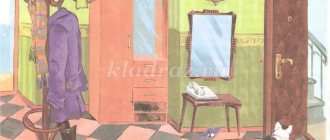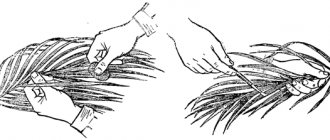Video speech therapy session with children on the topic “Furniture”
Drawing with children 3-4 years old. Class notes Koldina Daria Nikolaevna
Theme of the week: “Furniture”
Lesson 10. Rug for bunnies
(Brush painting. Watercolor paints)
Target.
Teach children to decorate a rectangular object, alternating circles and lines (using a brush and watercolors); consistently use paints of two colors; independently come up with a pattern and place it over the entire surface of the object. Cultivate compassion and kindness.
Handout.
A rectangular rug cut from light-colored colored paper, watercolor paints, a brush, a jar of water.
Progress of the lesson
Read V. Berestov’s poem “Bunny” to the children:
Little bunnies
They wanted some goodies,
They wanted some goodies,
Because they are small.
Ask the guys: “What did the bunnies want to do? (Bayinki, go to sleep.)
Where can I put the bunnies?”
(In a box, on a chair, on a rug, etc.)
Place a rectangular rug cut out of light colored paper in front of each child and ask: “How can you decorate such a rug?” (Draw circles, triangles, lines, etc.)
Invite the kids to make beautiful rugs for the bunnies, decorating them with alternating multi-colored circles and lines.
At the end of the lesson, ask each child: “What kind of rug did you make? (Beautiful, elegant, colorful, affectionate, etc.)
Do you think it will be nice for bunnies to sleep on such a rug?”
From the book Modeling and application with children 6-7 years old.
Lesson notes by the author Daria Nikolaevna Koldina Theme of the week “My Home” Lesson 21. Building a house (Modeling from plasticine) Program content. To develop in children the ability to sculpt a house from rolled up columns, placing them on top of each other and firmly connecting them together. Strengthen the ability to use a stack. Develop
From the book Drawing with children 6-7 years old. Lesson notes author Koldina Daria Nikolaevna
Topic of the week: “My Home” Lesson 41–42. Houses of the Three Little Pigs (part 1–2) (Drawing with pastel crayons, sanguine, charcoal, wax crayons) Program content. Continue learning how to make illustrations for fairy tales. Develop the ability to arrange objects on a sheet of paper. Learn
From the book Drawing with children 4-5 years old. Lesson notes author Koldina Daria Nikolaevna
Topic of the week: “Furniture” Lesson 11. Blanket for Vanyushka (Drawing with felt-tip pens) Program content. Teach children to decorate a rectangular object with colored stripes, alternating them by color. Learn to understand and analyze the content of the nursery rhyme. Cultivate benevolence
From the book Lepka with children 4-5 years old. Lesson notes author Koldina Daria Nikolaevna
Theme of the week “My Home” Lesson 21. Houses for nesting dolls (Drawing with colored pencils) Program content. Teach children to draw small and large objects consisting of a square and a triangle. Continue learning how to compose a plot composition. Cultivate responsive
From the book Lepka with children 3-4 years old. Lesson notes author Koldina Daria Nikolaevna
Topic of the week: “Furniture” Lesson 11. Table and chair (Plasticine molding) Program content. Learn to cut elongated plasticine columns into pieces using a stack and attach them to cardboard, depicting pieces of furniture in the form of a bas-relief (the image protrudes above
From the book Drawing with children 5-6 years old. Lesson notes author Koldina Daria Nikolaevna
Theme of the week “My Home” Lesson 22. House for a bunny and a rooster (Plasticine modeling) Program content. Strengthen children's ability to bring a product to the desired image using plasticine. Learn to retell fairy tales based on illustrations. Demonstration material. Heroes
From the book Application with children 3-4 years old. Lesson notes author Koldina Daria Nikolaevna
Theme of the week “In the kitchen” Lesson 17. Gzhel cup (Painting with gouache) Program content. Introduce children to Gzhel. Learn to highlight the characteristic features of Gzhel painting, decorate the border of a cup with simple elements of painting (straight and wavy lines of various
From the book Drawing with children 3-4 years old. Lesson notes author Koldina Daria Nikolaevna
Theme of the week “In the room” Lesson 19. Carpet (Decorative drawing with felt-tip pens) Program content. Learn to draw patterns on the carpet in the form of long, non-touching lines. To develop children's aesthetic perception, fantasy and imagination. Cultivate love for Russians
From the author's book
Theme of the week “Professions” Lesson 23. Color spectrum (Drawing with gouache) Program content. Form an idea of how you can get orange, green, purple and brown colors. Learn to mix basic paints and create new colors. Actively
From the author's book
Topic of the week: “Zoo” Lesson 25. Elephant (Palm drawing) Program content. Continue to introduce the technique of palm printing: dip your entire palm in gouache and make an imprint. Develop imagination, teach to see a new image in a familiar object. Strengthen the skill
From the author's book
Theme of the week “Theater” Lesson 27. Three bears (Drawing with sanguine) Program content. Continue to introduce children to sanguine. Learn to draw sanguine in chalk and shade lines. Continue practicing graphically depicting animals standing on their hind legs. Fasten
From the author's book
Theme of the week “My Home” Lesson 41. Ice hut (Drawing with pastel crayons) Program content. Continue to introduce children to cool tones. Learn to convey the characteristic features of objects using cool colors. Introduce opportunities
From the author's book
Topic of the week: “Furniture” Lesson 10. Blanket (Colored paper. Decorative applique) Program content. Continue learning how to apply glue to parts and stick them on a sheet of paper. Learn to make a pattern of circles on a square sheet of paper, alternating them by color. Learn
From the author's book
Theme of the week “My Home” Lesson 22. House for a bunny and a rooster (Colored paper. Application from prepared parts of an object) Program content. Cultivate compassion and kindness. Teach children to form a whole from several parts; apply glue to the part and stick it
From the author's book
Topic of the week: “Furniture” Lesson 10. Rug for rabbits (Brush painting. Watercolors) Purpose. Teach children to decorate a rectangular object, alternating circles and lines (using a brush and watercolors); consistently use paints of two colors;
From the author's book
Topic of the week: “My Home” Lesson 22. Fence near the house (Brush painting. Gouache) Purpose. Continue to teach children to draw various objects consisting of combinations of lines. Learn to retell fairy tales based on illustrations in the book. Develop speech and thinking. Demonstration
Yulia Toshman
Methodological development for speech development for children 4–5 years old on the topic “Furniture”
Methodological development for speech development for children 4-5
“
Furniture ”
.
Yulia Toshman
Methodological development for speech development
“
Furniture ”
.
Methodological development
.
Educational area: speech development
.
Explanatory note: Methodological development compiled for children
4-5 years in accordance with the age characteristics
of children
, does not
contradict
educational standards and ensures the integrity of the educational process.
Purpose of development
:
development of speech hearing
, memory, coherent
speech
.
Development of fine motor skills of the hands
, coordination
of speech with movement
.
Develop the ability to care for furniture
and treat it with care.
Equipment: toy furniture
, object pictures,
cut-out pictures “
Furniture ”
, counting sticks for construction, a set of basic geometric shapes, a sensory-tactile set for each child
Main features of the style
The stylistic principles of eco-design are driven by the ideas of preserving nature and admiring its beauty. Let's list the main features of eco style:
- The use of high-quality natural materials not only in decoration and furniture, but also in decoration. As already mentioned, materials can also be recycled, degradable and renewable in nature.
- Refusal of plastic, synthetic fabrics, and, if possible, leather.
- Minimalism in the shapes and lines of furniture, decoration and decor.
- Neutral colors, but with bright accents. Primary colors: white, beige, brown, green, ocher, terracotta and other natural colors.
- References to the theme of forest and nature, flora and fauna, which can be read on wallpaper, curtains, in the design of lamps and wall decor.
- It would be great if the interior contained furniture or handmade items.
Planning the lighting
An eco-style children's room can be illuminated with lamps made of glass, metal, wood, fabric, paper, rattan or a cascade of mother-of-pearl plates.
- If you really want to decorate the room with a bright plastic lamp, then choose a product made of polypropylene. Why from him? The fact is that this plastic can be recycled, it is harmless not only to human health, but also to the environment.
By the way, it is recommended to choose LED light bulbs - the most environmentally friendly light bulbs of all possible. They are safe to drop and break, they practically do not heat up, save energy and do not require special disposal. The worst choice may be fluorescent light bulbs, which contain mercury and therefore require special disposal and careful handling.
Choosing eco-finishing
To decorate any children's room, it is worth choosing natural materials, let alone an eco-friendly children's room.
- It is better to choose wooden baseboards, windows and doors.
To finish the floor, you should choose: cork, natural linoleum, parquet board, piece parquet or wooden floor board. Everything is clear with wooden coverings - they are warm, durable, beautiful and... expensive. What can you say about cork and natural linoleum? These materials are cheaper, but are in many ways superior to wood flooring.
Natural linoleum (marmoleum) consists of jute fabric, as well as linseed oil, wood flour, resin, and natural dyes. It is good because it has bactericidal properties, is resistant to abrasion and deformation, is pleasant to the touch, can be locally repaired, does not support combustion, does not attract dust and, moreover, can withstand frequent washing. Natural linoleum has only a couple of disadvantages - the complexity of installation and its specific appearance.
Cork is another champion among eco-coatings. It is not only environmentally friendly and hypoallergenic, but also has a shock-absorbing effect, does not slip, is easy to clean, and is not subject to burning or rotting. The only thing she is afraid of is falling sharp objects and prolonged exposure to moisture.
To decorate the walls in an eco-friendly nursery, paper wallpaper, the same cork, non-woven wallpaper for painting, or painting the walls with water-based paint labeled Kids (or “For children’s rooms”) are suitable. Vinyl wallpaper should be abandoned, although its harm has not been proven; it clearly contradicts the concept of eco-design, and besides, it looks unnatural.
Below we present a selection of photo examples of wall decoration in eco style.
As for the ceiling, ideally it just needs to be whitewashed and painted. However, a suspended ceiling will not do any harm, but it will be very practical and indistinguishable from whitewash. The main thing here is to choose a matte canvas from a trusted manufacturer.






